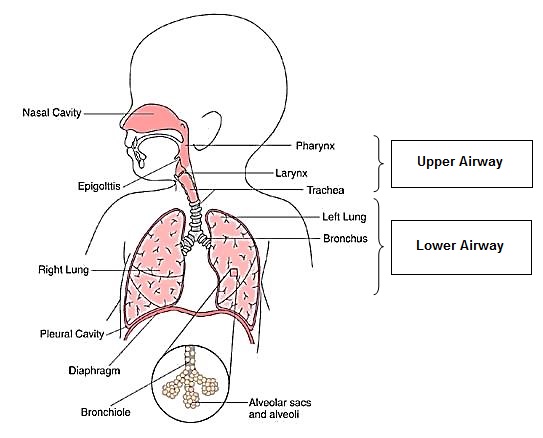Sleep is an important part of human daily routine and physiological needs.Adequate sleep is important for human being to function properly in their daily activity. Adequate sleep is important for children in terms of duration and quality so that they can grow, develop and function properly.
Obstructive sleep apnea syndrome (OSAS) is a form of sleep disorder found in children. The American Thoracic Society and The American Academy of Paediatrics define OSAS as a sleep-related breathing disorder with intermittent upper airway obstruction that disrupts normal sleep pattern.It will result in inadequate air reaching the lung during breathing (decreased oxygen saturation) or arousals from sleep. Air contains oxygen which is a very important element for the proper function of the organs especially the brain (it can have effects on childhood behavior, metabolism, neurodevelopment and overall health). Inadequate oxygen will cause many body organs unable to function properly. The obstructed upper airway will produce snoring sound during sleep. Around 10% of children frequently snore during sleep. However only 10 -20% of them have OSAS.
Airway and lung

Causes and risk factors of OSAS
OSAS is due to a significant obstruction of the upper airway during sleep. In normal children, the obstruction can be due to either enlarged adenoid tissue or enlarged tonsil or both. In obese children, the increased amount of fat tissue around the upper airway also contribute to upper airway obstruction.
In children who have abnormal shape of the face like Down syndrome, it will results in a narrow and crowded space of the upper airway causing it to be easily obstructed during sleep. In children with muscle disease such as muscle weakness, the airway is easily obstructed since the muscle cannot prevent the airway from collapsing during breathing. Those with cleft lip or palate are also at risk.
Other risk factors for OSAS in children are exposure to cigarette smoke, history of asthma or allergic rhinitis, recurrent tonsillitis and being of male gender.
However in some children there is no obvious explanation why the upper airway is obstructed during sleep.

Source: www.diagnosingsleepapnea.com
When to suspect your child is having OSAS
The main symptom is snoring. Other sign and symptoms are:
- Restless sleeper and preference to sleep in a prone position.
- Breathing heavily during sleep.
- The breathing ceases temporarily during sleep and sometimes produces coughing, gagging like sound before regaining the breath.
- Have frequent awakening during sleeping.
- Bedwetting.
- Difficulty waking up in the morning.
- Looking tired, sleepy and complaining of having a headache upon waking up in the morning.
- Sleepy during daytime and sleep inappropriately during daytime such as sleeping in class or in the car when going to and back from school.
- Frequently needing a nap in the daytime and the amount is not appropriate to age.
- Decrease or poor in school performance.
- Unable to cope with school lessons and have poor memory especially with school lesson.
- Look tired, lethargic, have poor initiative.
- Hyperactive child, difficult to control, very moody, easily throwing tantrums.
- Frequently having sneezing, runny nose and prefer to breathe through the mouth.
Complications of OSAS
OSAS can cause long-term complications. This include
- Decrease in school performance and learning problems.
- Behavioral problems such as hyperactive, temper tantrum, moody, lack initiative, persistent tiredness.
- Hypertension.
- Heart failure.
Treatment and prevention
Children with OSAS can be treated appropriately according to the causes. However they should be seen by doctors in order to assess the severity of the OSAS. These children may need a few investigations to confirm OSAS and to look at the complication following OSAS. Some of these children may need sleep study to confirm and to assess the severity of OSAS.
Treatment depends on the severity and these include operation to excise adenoid and tonsillar tissue (adenotonsillectomy), using breathing machines (CPAP and BiPAP machine), weight loss or nasal spray.
OSAS can be prevented by having good habits such as proper dietary habits that prevent obesity, regular exercise, do not smoke, proper treatment of allergic rhinitis and asthma.
Source: www.health.harvard.edu
Conclusion
Parents should be aware if their child loudly snores during sleep, having fragmented sleep and behavioral issues should be screened for OSAS. .OSAS which is left untreated can affect the health of the children.
Reference
- Gouthro K, Slowik JM. Pediatric Obstructive Sleep Apnea. [Updated 2023 May 1]. In: StatPearls [Internet]. Treasure Island (FL): StatPearls Publishing; 2024 Jan. https://www.ncbi.nlm.nih.gov/books/NBK557610
|
Last Reviewed |
: |
10 May 2024 |
|
Writer |
: |
Dr. Ahmad Fadzil b. Abdullah |
|
Accreditor |
: |
Dr. Norzila bt. Mohamed Zainuddin |
|
Reviewer |
: |
Dr. Farah Liyana bt Ahmad Zainuddin |







